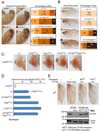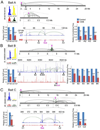Poly(ADP-ribosyl)ation regulates insulator function and intrachromosomal interactions in Drosophila
- PMID: 24055367
- PMCID: PMC3816015
- DOI: 10.1016/j.cell.2013.08.052
Poly(ADP-ribosyl)ation regulates insulator function and intrachromosomal interactions in Drosophila
Abstract
Insulators mediate inter- and intrachromosomal contacts to regulate enhancer-promoter interactions and establish chromosome domains. The mechanisms by which insulator activity can be regulated to orchestrate changes in the function and three-dimensional arrangement of the genome remain elusive. Here, we demonstrate that Drosophila insulator proteins are poly(ADP-ribosyl)ated and that mutation of the poly(ADP-ribose) polymerase (Parp) gene impairs their function. This modification is not essential for DNA occupancy of insulator DNA-binding proteins dCTCF and Su(Hw). However, poly(ADP-ribosyl)ation of K566 in CP190 promotes protein-protein interactions with other insulator proteins, association with the nuclear lamina, and insulator activity in vivo. Consistent with these findings, the nuclear clustering of CP190 complexes is disrupted in Parp mutant cells. Importantly, poly(ADP-ribosyl)ation facilitates intrachromosomal interactions between insulator sites measured by 4C. These data suggest that the role of insulators in organizing the three-dimensional architecture of the genome may be modulated by poly(ADP-ribosyl)ation.
Copyright © 2013 Elsevier Inc. All rights reserved.
Figures






Comment in
-
For genomes to stay in shape, insulators must be up to PAR.Cell. 2013 Sep 26;155(1):15-6. doi: 10.1016/j.cell.2013.09.012. Cell. 2013. PMID: 24074855
References
-
- Ahel I, Ahel D, Matsusaka T, Clark AJ, Pines J, Boulton SJ, West SC. Poly(ADP-ribose)-binding zinc finger motifs in DNA repair/checkpoint proteins. Nature. 2008;451:81–85. - PubMed
-
- Barges S, Mihaly J, Galloni M, Hagstrom K, Muller M, Shanower G, Schedl P, Gyurkovics H, Karch F. The Fab-8 boundary defines the distal limit of the bithorax complex iab-7 domain and insulates iab-7 from initiation elements and a PRE in the adjacent iab-8 domain. Development. 2000;127:779–790. - PubMed
-
- Capelson M, Corces VG. The ubiquitin ligase dTopors directs the nuclear organization of a chromatin insulator. Mol Cell. 2005;20:105–116. - PubMed
Publication types
MeSH terms
Substances
Associated data
- Actions
Grants and funding
LinkOut - more resources
Full Text Sources
Other Literature Sources
Molecular Biology Databases

